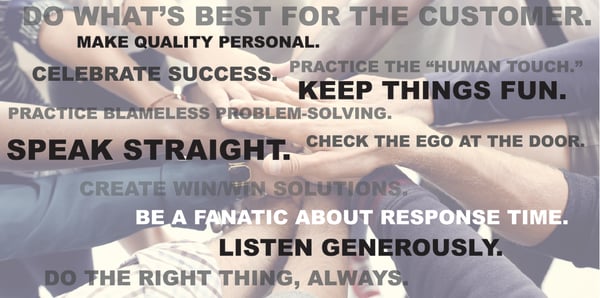
How to Define Your Company Culture with a Common Language
By Candace Coleman, CultureWise Content Manager
Many executives spend time honing core values they want their employees to embrace and reflect. This undertaking usually involves creating a list of “concept words” like honor, quality, and teamwork and then making them visible companywide to inspire their people.
Developing a set of guiding principles can formalize what a company stands for and be a basis for its corporate culture.
But if leaders were to ask employees for their definitions of these terms, they’re likely to get all kinds of answers. That’s because values are abstract ideas that can signify many things to different people. For example, a person’s background and experiences can play a large part in how they perceive a word like “honor.”
When it comes to aligning a team and bringing out the best in every employee, core values aren’t enough.
Shifting from Values to Behaviors
The goal of establishing company values is for employees to reflect the qualities that their CEO is passionate about. But for staff to understand their thinking and live up to these values, leaders need to do more than frame them on the walls. They should explain what these principles look like in action.
If they take the time to do that, they’re no longer talking about values—they’re describing behaviors. And now they’re on to something.
Values are inspirational, but behaviors are the real essence of a company’s culture.
It’s much more effective for leaders to think beyond values and determine how they want their team to act as they represent their company. After identifying these behaviors, they need to define them so that everyone in the organization understands them the same way. In so doing, they’ll develop a common language that describes how their people should operate and why.
Once established, a common language eliminates confusion and misinterpretation of values and creates clarity around a leader’s expectations and goals.
As author and business development expert Kevin Allen tells leaders, the language they develop “offers rich opportunities to codify and crystallize what your company is about, and what your company seeks.”
How Do You Create a Language?
The point of developing a common language is to articulate the behaviors that will build the company envisioned by its chief executive. It’s not a task the leader should delegate to others because it’s based on their personal insight and perspective. But they also don’t have to do it alone.
A reasonable approach would be for the CEO to assemble a senior leadership team to ask for their contributions. Author and CultureWise Founder David Friedman describes how he goes through this process in his book, Culture by Design. He recommends pulling together a group of five to eight people—or enough to get some dialogue and discussion going and to get various ideas on the table.
But he cautions leaders to be clear to everyone that it’s not a group decision. The team is lending ideas, but the person at the top ultimately decides upon the language. That’s part of what makes it so powerful.
With that understanding, the group should have two goals:
- Determine a list of behaviors that will enable employees and the organization to thrive
- Define those behaviors in a way that everyone on staff can relate to and perform them
Making a List of Behaviors
The leader should ask the group to consider operational goals and then think about the kind of conduct and attitudes it would take to achieve them.
Friedman advises leaders to temporarily set aside any “legacy materials,” such as the company’s formal vision, mission, and core values during this exercise. Beginning with a clean slate, he says, will allow the group to think more freely.
Throughout the brainstorming session, the team should be talking about:
- The things that, if done more consistently, would make the company exceptional
- Current unproductive or even destructive behaviors and what should replace them
- Identifying the behaviors exhibited by outstanding team members
The list should include:
- Areas of conduct that are currently helping the company succeed
- Aspirational behaviors that will take the company even higher
Friedman suggests that it may be helpful to sort the list into four categories:
- How we work with customers
- How we work with each other
- How we do our own work
- Our attitude
The group should bear in mind that the behaviors should be actions, not ideas. For instance, instead of “Integrity,” the behavior’s title could be “Do the Right Thing, Always.” Or “Demonstrate a Passion for Excellence” is much easier for people to visualize than merely saying “Quality.”
Describing the Behaviors
Once the list is established, the behaviors must be fine-tuned and defined to be explicit yet universal. Two to four sentences are usually sufficient to explain what each behavior means.
One of the examples Friedman uses in his book is:
HONOR COMMITMENTS. Do what you say you’re going to do, when you say you’re going to do it. This includes being on time for all phone calls, appointments, and meetings. If a commitment can’t be fulfilled, notify others early and agree upon a new deliverable to be honored.
An exercise that can be helpful in writing good descriptions is to picture someone performing the behavior successfully. Consider everything they would do to embody this conduct, and then use that vision to write a succinct definition.
A few other tips that Friedman shares in the book are:
- It’s usually better to describe what people should do, rather than what they shouldn’t do
- Don’t crowd too many concepts into one broad “behavior”
- The behaviors and their descriptions should be enduring—not “flavor of the month” ideas
After the language is formalized, leadership should incorporate it into all aspects of training and everyday rituals and discussions. It won’t be useful and meaningful unless it is in constant use.
Advantages of a Common Language
Exceptional behaviors, described by a common language, provide a foundation for a high-performing company culture. When properly introduced and reinforced, the lexicon makes the workforce more cohesive, responsive, and rooted in organizational goals.
6 benefits of a common language
1. Shared expectations
Because everyone is using the same terminology, expectations are more easily aligned. Misunderstandings are minimized, and the time formerly spent on getting things straight can be devoted to productivity.
2. Consistency
A universal vocabulary to describe how people should work will generate:
- More consistent outcomes
- Heightened efficiencies
- Enhanced customer experiences
3. Stronger management/staff ties
Relationships between managers and direct reports are healthier when everyone is confidently on the same page. The common language allows all staff members to strategize and approach goals from the same perspective.
4. Tighter internal communication
A shared language eliminates the need for constant clarification—or even translation—of what a coworker says or puts in writing. Not only is the terminology immediately understood, so is the meaning behind the words.
5. Better collaboration
When leaders create a common language and encourage staff to use it, departmental or group silos are less likely to develop. People from different areas of the company can more easily and enjoyably work together. And the company language makes it easier for remote staff and contract workers to be on the same wavelength as on-site employees.
6. Camaraderie and shared purpose
A common language is a team-building tool. It helps people feel like they belong within an organization and emphasizes that everyone is on the same side. Because goals are clearly articulated and understood, staff members are inspired and mobilized to excel.
Common Language vs. Word Salad
There is a distinction between a common language and internal lingo that may be exclusive. The latter, which can include acronyms, abbreviations, inside jokes, and departmental jargon, can act more like walls around certain groups instead of words that increase understanding.
This kind of internal language can be intimidating to coworkers who aren’t “in the know” and prevent them from asking valuable questions. It can make simple tasks seem more complicated than necessary and can even be used in coded insults. Inside dialect can be divisive among team members and become a barrier between staff members and customers.
Analytical Consultant Edgar Wilson makes this point:
“The difference between building fences and opening doors with language is a combination of intent and attention. Becoming more self-aware about the language we use as individuals, departments, teams, and organizations can wake us up to obstacles we have created as well as opportunities to change habits.”
The type of common language described in the first part of this article is never divisive; it builds bridges.
The Power of a Common Language
“The way in which we think about the world is directly influenced by the language we use to talk about it,” according to Professor Fatiha Guessabi in Language Magazine. She is writing from a scholarly, global perspective, but her words also apply to a business organization’s lexicon. The company’s standard terminology frames employees’ perceptions about how to do their jobs.
David Friedman notes that for businesses:
“A common language becomes a lens through which each staff member begins to see and talk about everything in the organization.”
Everyone in the company uses the same lens, so they have a shared understanding of what to do and how to do it. Leaders who create a common language provide their staff with a guidebook and vocabulary to build a positive future for their company. It is an incredibly powerful tool.
Resources to Create a Common Language
Defining behaviors to create a common language is the first part of David Friedman’s eight-step framework to transform company culture. In Culture by Design, Friedman provides simple, clear guidelines and insights about establishing the right wording and then putting the language into action.
Learn more about developing and improving corporate culture with a free, two-chapter download of this valuable resource.
The book inspired CultureWise—a turnkey operating system for culture. Explore the CultureWise website for more information about this revolutionary program and the options it provides.
Stay up to date on the latest topics about company culture and business with a complimentary subscription to “Culture Matters,” a weekly newsletter published by CultureWise.

